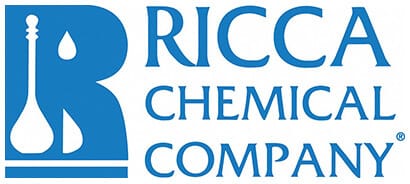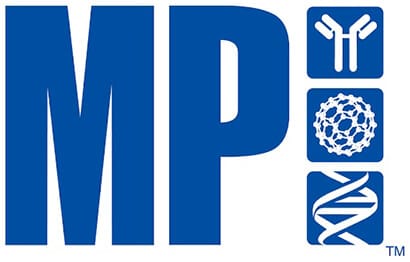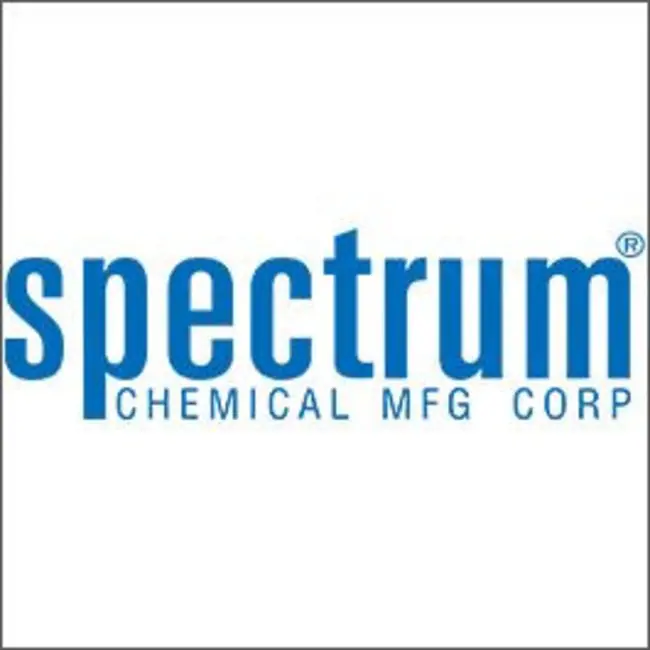Showing 246851–246900 of 271967 results
-
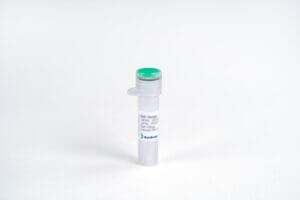
TGF-β 2, Human
$543.38 Add to cart View Product DetailsTransforming growth factor beta-2 (TGF-β2) is a secreted protein which belongs to the TGF-beta family. It is known as a cytokine that performs many cellular functions and has a vital role during embryonic development. The precursor is cleaved into mature TGF-beta-2 and LAP, which remains non-covalently linked to mature TGF-beta-2 rendering it inactive. It is an extracellular glycosylated protein. It is known to suppress the effects of interleukin dependent T-cell tumors. Defects in TGFB2 may be a cause of non-syndromic aortic disease (NSAD).
-
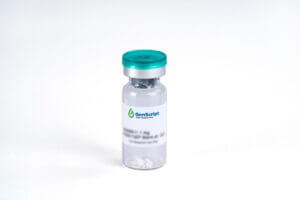
TGF-β 2, Mouse
$2,876.44 Add to cart View Product DetailsTransforming growth factor beta 2 (TGF-β2) is a member of TGF-beta superfamily that shares a characteristic cysteine knot structure. Mice with TGF-β2 gene deletion show defects in development of cardiac, lung, craniofacial, limb, spinal column, eye, inner ear and urogenital systems. All TGF-β isoforms signal via the same heteromeric receptor complex, consisting of a ligand binding TGF-β receptor type II (TβR-II), and a TGF-β receptor type I (TβR-I). Signal transduction from the receptor to the nucleus is mediated via SMADs. TGF-β expression is found in cartilage, bone, teeth, muscle, heart, blood vessels, hematopoietic cells, lung, kidney, gut, liver, eye, ear, skin, and the nervous system.
-

TGF-β 2, Mouse
$194.06 Add to cart View Product DetailsTransforming growth factor beta 2 (TGF-β2) is a member of TGF-beta superfamily that shares a characteristic cysteine knot structure. Mice with TGF-β2 gene deletion show defects in development of cardiac, lung, craniofacial, limb, spinal column, eye, inner ear and urogenital systems. All TGF-β isoforms signal via the same heteromeric receptor complex, consisting of a ligand binding TGF-β receptor type II (TβR-II), and a TGF-β receptor type I (TβR-I). Signal transduction from the receptor to the nucleus is mediated via SMADs. TGF-β expression is found in cartilage, bone, teeth, muscle, heart, blood vessels, hematopoietic cells, lung, kidney, gut, liver, eye, ear, skin, and the nervous system.
-

TGF-β 2, Mouse
$543.38 Add to cart View Product DetailsTransforming growth factor beta 2 (TGF-β2) is a member of TGF-beta superfamily that shares a characteristic cysteine knot structure. Mice with TGF-β2 gene deletion show defects in development of cardiac, lung, craniofacial, limb, spinal column, eye, inner ear and urogenital systems. All TGF-β isoforms signal via the same heteromeric receptor complex, consisting of a ligand binding TGF-β receptor type II (TβR-II), and a TGF-β receptor type I (TβR-I). Signal transduction from the receptor to the nucleus is mediated via SMADs. TGF-β expression is found in cartilage, bone, teeth, muscle, heart, blood vessels, hematopoietic cells, lung, kidney, gut, liver, eye, ear, skin, and the nervous system.
-

TGF-β 3, Human
$2,876.44 Add to cart View Product DetailsTransforming growth factor beta 3(TGFB3) is a member of a TGF -β superfamily which is defined by their structural and functional similarities. TGFB3 is secreted as a complex with LAP. This latent form of TGFB3 becomes active upon cleavage by plasmin, matrix metalloproteases, thrombospondin -1, and a subset of integrins. It binds with high affinity to TGF- β RII, a type II serine/threonine kinase receptor. TGFB3 is involved in cell differentiation, embryogenesis and development. It is believed to regulate molecules involved in cellular adhesion and extracellular matrix (ECM) formation during the process of palate development. Without TGF-β3, mammals develop a deformity known as a cleft palate.
-

TGF-β 3, Human
$194.06 Add to cart View Product DetailsTransforming growth factor beta 3(TGFB3) is a member of a TGF -β superfamily which is defined by their structural and functional similarities. TGFB3 is secreted as a complex with LAP. This latent form of TGFB3 becomes active upon cleavage by plasmin, matrix metalloproteases, thrombospondin -1, and a subset of integrins. It binds with high affinity to TGF- β RII, a type II serine/threonine kinase receptor. TGFB3 is involved in cell differentiation, embryogenesis and development. It is believed to regulate molecules involved in cellular adhesion and extracellular matrix (ECM) formation during the process of palate development. Without TGF-β3, mammals develop a deformity known as a cleft palate.
-

TGF-β 3, Human
$543.38 Add to cart View Product DetailsTransforming growth factor beta 3(TGFB3) is a member of a TGF -β superfamily which is defined by their structural and functional similarities. TGFB3 is secreted as a complex with LAP. This latent form of TGFB3 becomes active upon cleavage by plasmin, matrix metalloproteases, thrombospondin -1, and a subset of integrins. It binds with high affinity to TGF- β RII, a type II serine/threonine kinase receptor. TGFB3 is involved in cell differentiation, embryogenesis and development. It is believed to regulate molecules involved in cellular adhesion and extracellular matrix (ECM) formation during the process of palate development. Without TGF-β3, mammals develop a deformity known as a cleft palate.
-
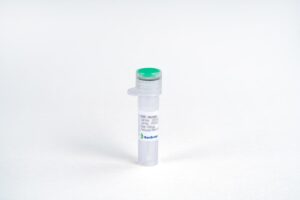
TGF-β1, Human
$2,876.44 Add to cart View Product DetailsTGF-β1 (transforming growth factor beta 1) is one of three closely related mammalian members of the large TGF-β1 superfamily that share a characteristic cystine knot structure. TGF-β1, -2 and -3 are highly pleiotropic cytokines that act as cellular switches to regulate processes such as immune function, proliferation and epithelial-mesenchymal transition. Each TGF-β isoform has some non-redundant function; for TGF-β1, mice with targeted deletion show defects in hematopoiesis and endothelial differentiation and died of overwhelming inflammation. TGF-β1 signaling begins with high-affinity binding to a type II ser/thr kinase receptor termed TGF-β RII. This receptor then phosphorylates and activates a second ser/thr kinase receptor, TGF-β RI (also called activin receptor‑like kinase (ALK)-5), or alternatively, ALK-1. This complex phosphorylates and activates Smad proteins that regulate transcription.
-

TGF-β1, Human
$146.63 Add to cart View Product DetailsTGF-β1 (transforming growth factor beta 1) is one of three closely related mammalian members of the large TGF-β1 superfamily that share a characteristic cystine knot structure. TGF-β1, -2 and -3 are highly pleiotropic cytokines that act as cellular switches to regulate processes such as immune function, proliferation and epithelial-mesenchymal transition. Each TGF-β isoform has some non-redundant function; for TGF-β1, mice with targeted deletion show defects in hematopoiesis and endothelial differentiation and died of overwhelming inflammation. TGF-β1 signaling begins with high-affinity binding to a type II ser/thr kinase receptor termed TGF-β RII. This receptor then phosphorylates and activates a second ser/thr kinase receptor, TGF-β RI (also called activin receptor‑like kinase (ALK)-5), or alternatively, ALK-1. This complex phosphorylates and activates Smad proteins that regulate transcription.
-

TGF-β1, Human
$370.88 Add to cart View Product DetailsTGF-β1 (transforming growth factor beta 1) is one of three closely related mammalian members of the large TGF-β1 superfamily that share a characteristic cystine knot structure. TGF-β1, -2 and -3 are highly pleiotropic cytokines that act as cellular switches to regulate processes such as immune function, proliferation and epithelial-mesenchymal transition. Each TGF-β isoform has some non-redundant function; for TGF-β1, mice with targeted deletion show defects in hematopoiesis and endothelial differentiation and died of overwhelming inflammation. TGF-β1 signaling begins with high-affinity binding to a type II ser/thr kinase receptor termed TGF-β RII. This receptor then phosphorylates and activates a second ser/thr kinase receptor, TGF-β RI (also called activin receptor‑like kinase (ALK)-5), or alternatively, ALK-1. This complex phosphorylates and activates Smad proteins that regulate transcription.
-
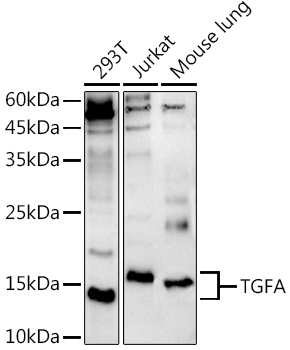
TGFA Rabbit pAb
$86.94 Add to cart View Product DetailsPolyclonal Antibodies
-

TGFA Rabbit pAb
$239.89 Add to cart View Product DetailsPolyclonal Antibodies
-
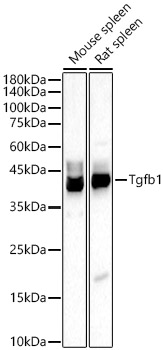
Tgfb1 Rabbit pAb
$239.89 Add to cart View Product DetailsPolyclonal Antibodies
-

Tgfb1 Rabbit pAb
$86.94 Add to cart View Product DetailsPolyclonal Antibodies
-

TGFB1I1 Rabbit pAb
$86.94 Add to cart View Product DetailsPolyclonal Antibodies
-

TGFB1I1 Rabbit pAb
$239.89 Add to cart View Product DetailsPolyclonal Antibodies
-

TGFB2 Rabbit pAb
$86.94 Add to cart View Product DetailsPolyclonal Antibodies
-

TGFB2 Rabbit pAb
$239.89 Add to cart View Product DetailsPolyclonal Antibodies
-
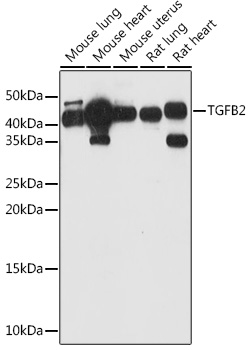
TGFB2 Rabbit pAb
$86.94 Add to cart View Product DetailsPolyclonal Antibodies
-

TGFB2 Rabbit pAb
$239.89 Add to cart View Product DetailsPolyclonal Antibodies
-

TGFB2 Rabbit pAb
$86.94 Add to cart View Product DetailsPolyclonal Antibodies
-

TGFB2 Rabbit pAb
$239.89 Add to cart View Product DetailsPolyclonal Antibodies
-
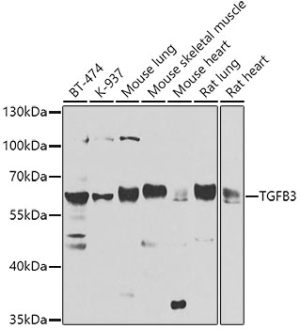
TGFB3 Rabbit pAb
$86.94 Add to cart View Product DetailsPolyclonal Antibodies
-

TGFB3 Rabbit pAb
$239.89 Add to cart View Product DetailsPolyclonal Antibodies
-
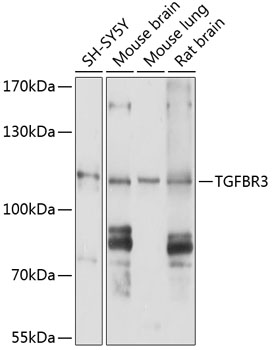
TGFBR3 Rabbit pAb
$86.94 Add to cart View Product DetailsPolyclonal Antibodies
-

TGFBR3 Rabbit pAb
$239.89 Add to cart View Product DetailsPolyclonal Antibodies
-

TGFβ1, Bovine
$2,742.75 Add to cart View Product DetailsTGF-β1 (transforming growth factor beta 1) is one of three closely related mammalian members of the large TGF-β1 superfamily that share a characteristic cystine knot structure. TGF-β1, -2 and -3 are highly pleiotropic cytokines that act as cellular switches to regulate processes such as immune function, proliferation and epithelial-mesenchymal transition. Each TGF-β isoform has some non-redundant function; for TGF-β1, mice with targeted deletion show defects in hematopoiesis and endothelial differentiation and died of overwhelming inflammation. TGF-β1 signaling begins with high-affinity binding to a type II ser/thr kinase receptor termed TGF-β RII. This receptor then phosphorylates and activates a second ser/thr kinase receptor, TGF-β RI (also called activin receptor‑like kinase (ALK)-5), or alternatively, ALK-1. This complex phosphorylates and activates Smad proteins that regulate transcription.
-

TGFβ1, Bovine
$142.31 Add to cart View Product DetailsTGF-β1 (transforming growth factor beta 1) is one of three closely related mammalian members of the large TGF-β1 superfamily that share a characteristic cystine knot structure. TGF-β1, -2 and -3 are highly pleiotropic cytokines that act as cellular switches to regulate processes such as immune function, proliferation and epithelial-mesenchymal transition. Each TGF-β isoform has some non-redundant function; for TGF-β1, mice with targeted deletion show defects in hematopoiesis and endothelial differentiation and died of overwhelming inflammation. TGF-β1 signaling begins with high-affinity binding to a type II ser/thr kinase receptor termed TGF-β RII. This receptor then phosphorylates and activates a second ser/thr kinase receptor, TGF-β RI (also called activin receptor‑like kinase (ALK)-5), or alternatively, ALK-1. This complex phosphorylates and activates Smad proteins that regulate transcription.
-

TGFβ1, Bovine
$589.09 Add to cart View Product DetailsTGF-β1 (transforming growth factor beta 1) is one of three closely related mammalian members of the large TGF-β1 superfamily that share a characteristic cystine knot structure. TGF-β1, -2 and -3 are highly pleiotropic cytokines that act as cellular switches to regulate processes such as immune function, proliferation and epithelial-mesenchymal transition. Each TGF-β isoform has some non-redundant function; for TGF-β1, mice with targeted deletion show defects in hematopoiesis and endothelial differentiation and died of overwhelming inflammation. TGF-β1 signaling begins with high-affinity binding to a type II ser/thr kinase receptor termed TGF-β RII. This receptor then phosphorylates and activates a second ser/thr kinase receptor, TGF-β RI (also called activin receptor‑like kinase (ALK)-5), or alternatively, ALK-1. This complex phosphorylates and activates Smad proteins that regulate transcription.
-
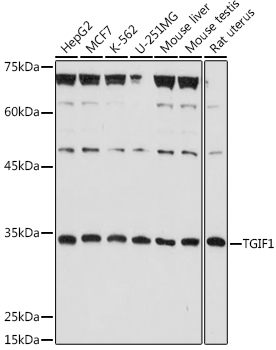
TGIF1 Rabbit pAb
$86.94 Add to cart View Product DetailsPolyclonal Antibodies
-

TGIF1 Rabbit pAb
$239.89 Add to cart View Product DetailsPolyclonal Antibodies
-
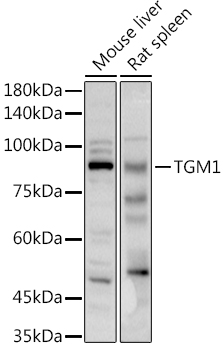
TGM1 Rabbit pAb
$239.89 Add to cart View Product DetailsPolyclonal Antibodies
-

TGM1 Rabbit pAb
$86.94 Add to cart View Product DetailsPolyclonal Antibodies
-

TGM3 Rabbit pAb
$86.94 Add to cart View Product DetailsPolyclonal Antibodies
-

TGM3 Rabbit pAb
$239.89 Add to cart View Product DetailsPolyclonal Antibodies
-

TGM3 Rabbit pAb
$86.94 Add to cart View Product DetailsPolyclonal Antibodies
-

TGM3 Rabbit pAb
$239.89 Add to cart View Product DetailsPolyclonal Antibodies
-

TGM5 Rabbit pAb
$86.94 Add to cart View Product DetailsPolyclonal Antibodies
-

TGM5 Rabbit pAb
$239.89 Add to cart View Product DetailsPolyclonal Antibodies
-

TGN46/TGOLN2 Rabbit mAb
$119.14 Add to cart View Product DetailsMonoclonal Antibodies
-

TGN46/TGOLN2 Rabbit mAb
$296.24 Add to cart View Product DetailsMonoclonal Antibodies
-

TGN46/TGOLN2 Rabbit pAb
$239.89 Add to cart View Product DetailsPolyclonal Antibodies
-

TGN46/TGOLN2 Rabbit pAb
$86.94 Add to cart View Product DetailsPolyclonal Antibodies
-
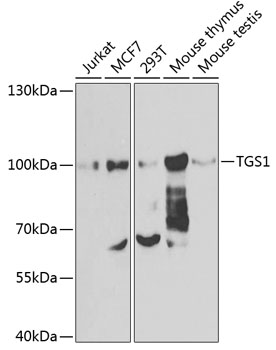
TGS1 Rabbit pAb
$86.94 Add to cart View Product DetailsPolyclonal Antibodies
-

TGS1 Rabbit pAb
$239.89 Add to cart View Product DetailsPolyclonal Antibodies
-
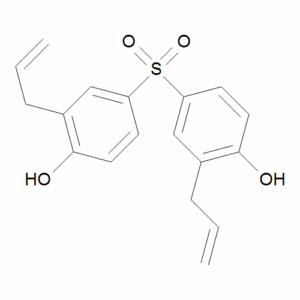
TGSH
$179.40 Add to cart View Product DetailsMolecular Formula : C18H18O4S
-

TGSH
$351.04 Add to cart View Product DetailsMolecular Formula : C18 H18 O4 S
-

TGSH
$716.74 Add to cart View Product DetailsMolecular Formula : C18 H18 O4 S
-

TGX-221
$50.89 Add to cart View Product DetailsMolecular Formula : C21H24N4O2
-

TGX-221
$72.45 Add to cart View Product DetailsMolecular Formula : C21H24N4O2


